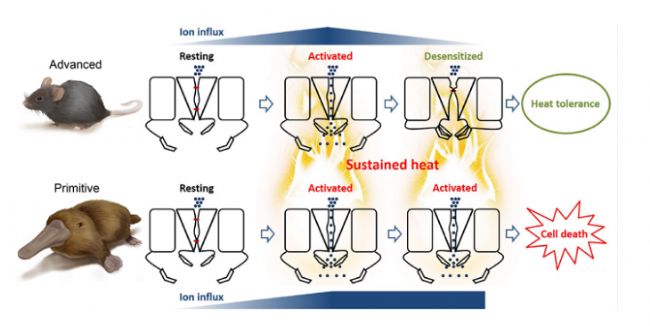
The transient receptor potential vanilloid 1, TRPV1 ion channel is a molecular sensor for mammals facing high temperature alarms. It is characterized by heat activation and high temperature-mediated inactivation due to its heat-induced activation (Ah). It is followed by rapid desensitization (Dh), which makes little sense of its role in sustained thermal reactions.
Researcher Lai Wei and researcher Yang Shilong of Kunming Institute of Zoology, Chinese Academy of Sciences, Professor Yang Fan of Zhejiang University and Professor Zheng Wei of the University of California, Davis, etc., with chimeric construction, unnatural amino acid labeling, fluorescence resonance energy transfer and allosteric conformation simulation The mouse TRPV1 channel (mV1) and the platypus TRPV1 channel (pV1) were compared to clarify the physiological role and structural basis of Dh. The findings were published in the May 14 issue of Nature Communications, entitled "Molecular Basis for Heat Desensitization of TRPV1 Ion Channels."
It was found that the N-terminus and C-terminus of mouse mV1 interacted at Dh, whereas the platypus pV1 did not have this feature and therefore did not have this allosteric process. When they grafted the N-terminus and C-terminus of mouse mV1 to pV1, and then constructed a chimeric channel carrying most of the pV1 structure, named pV1_mNC, surprisingly, compared to wild-type, pV1_mNC was also at 40 °C. It shows a Dh effect. In other words, the transmembrane domain of pV1_mNC can support Ah and Dh, and the reason for the lack of Dh in the platypus pV1 is likely to come from N-terminal or/and C-terminal changes.
The platypus is the only egg-born mammal on earth. It has been around 25 million years ago and still lives in Australia, with a small distribution. The obese body, the flat mouth, and the cute little eyes, spend most of their time in the water, stay warm in the colder waters, inactive or hibernate in the winter. Although they are mammals, they lack perfect thermoregulatory ability. When the ambient temperature drops to 0 °C, their body temperature fluctuates between 20-30 °C. When the ambient temperature rises to 30-35 °C, the thermal regulation mechanism is lost. death.
The article co-authored Dr. Luo Lei, Dr. Wang Yunfei and Dr. Li Bowen to further explore whether the structural change pattern of TRPV1 affects the heat resistance of mammals. By adding different lengths of free C-terminal peptide, the Dh of mV1 was characterized and the distal end was re-established. After the N and C-end models, some of the distal N and C deletions of the published single-particle cryo-electron microscopy (cryo-EM) were compensated.
Comparing pV1 and other mammalian TRPV1 channel sequences, several highly specific platypus amino acid sites were found at the C-terminus, and then the platypus trpv1 knock-in mice (provided by Saiye Bio) were constructed - p-trpv1 mice . With the exception of the N-terminus and the C-terminus, the transcriptional level of TRPV1 and other known thermosensory-related pathways did not change. Surprisingly, in the iris and hot plate tests, wild-type mice were more tolerant to long-term thermal stimulation (45 °C) than p-trpv1 mice, whereas p-trpv1 mice needed to be evaded by continuous walking. Hot plate stimulation. Moreover, long-term hot plate stimulation caused signs of burns on the soles of p-trpv1 mice, but had no significant effect on wild-type mice.
Studies have revealed that the allosteric nature of TRPV1 channel gating largely determines the physiological function of these channels. Previous KO mouse studies have demonstrated that TRPV1 contributes to mammalian thermal sensing physiology, but the observations are far from clear due to the tight coupling of the Dh and Ah processes. However, the transgenic p-trpv1 mice constructed in this experiment clearly clarified this point and revealed that Dh has an important protective effect on mammals living in a high temperature environment. As one of the most primitive mammals, the platypus has not evolved a high-temperature-mediated "activation-inactivation" equilibrium mechanism. Therefore, the platypus is extremely sensitive to the environment above the critical temperature and is difficult to adapt to other terrestrial living environments. The new TRPV1 model demonstrates the important biological significance of the molecular mechanism of heat inactivation to mammalian evolution.Original Search: Molecular basis for heat desensitization of TRPV1 ion channels, Nature Communications
Microscope Accessory ,Microscope Accessories Kit,Professional Microscope Parts,Microscope Camera Lens
Ningbo ProWay Optics & Electronics Co., Ltd. , https://www.proway-microtech.com